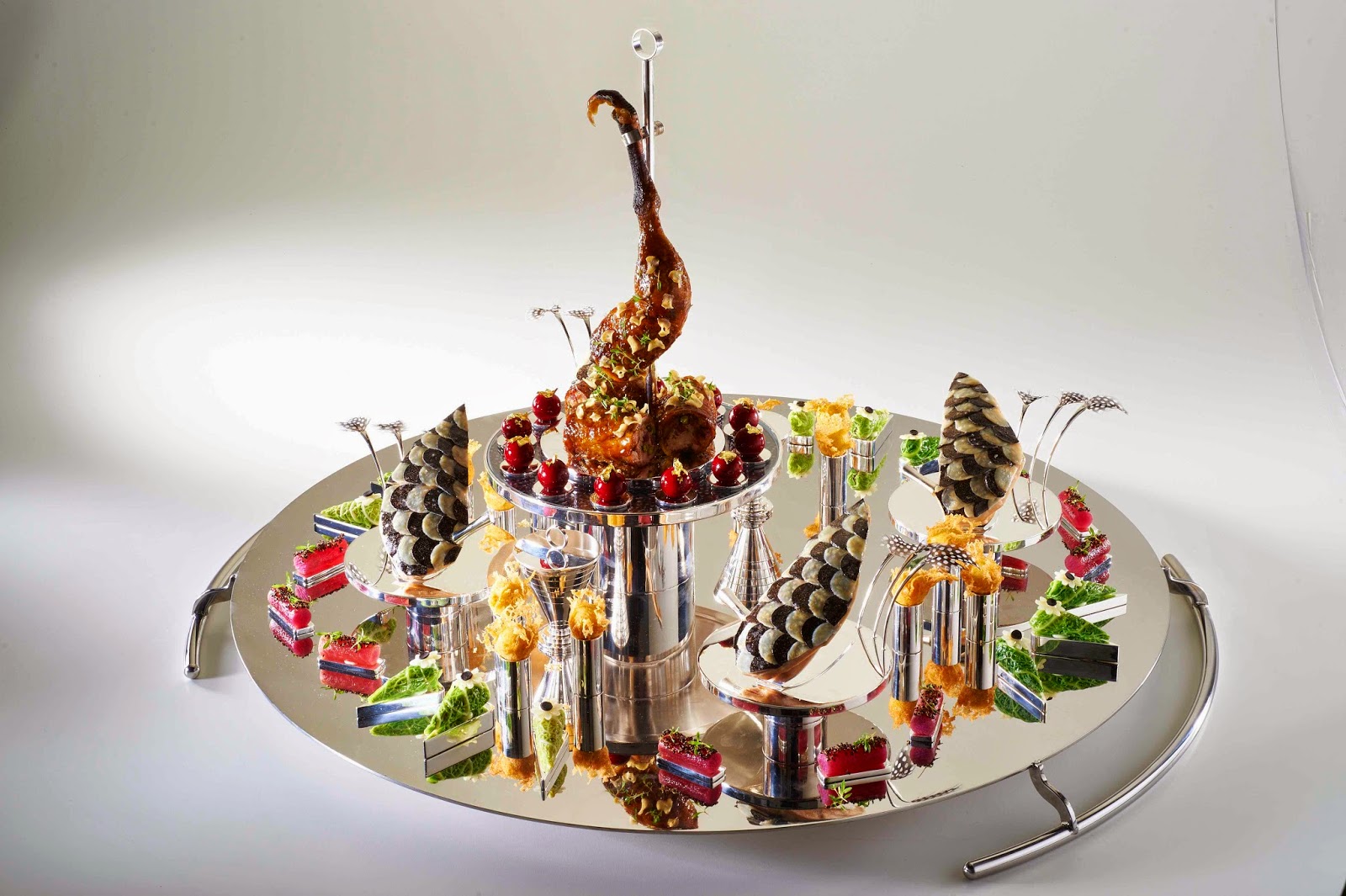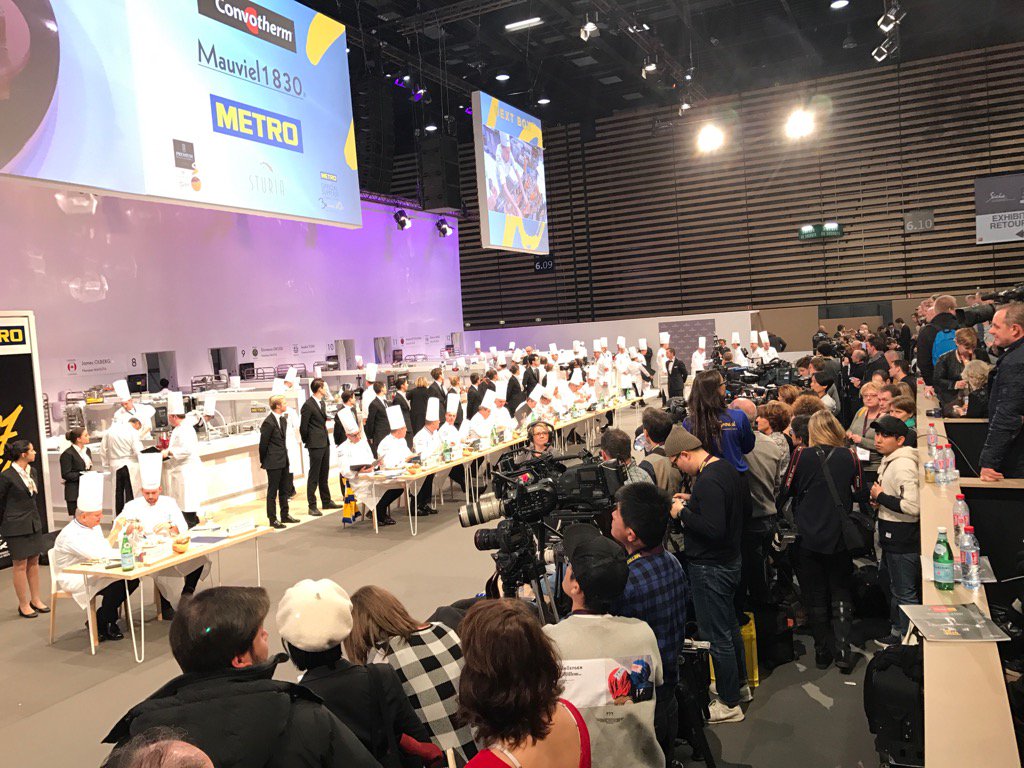
WALDHOTEL SONNORA

Holding three Michelin stars, and tucked way back in some woods between the wine village of Bernkastel and the city of Trier, the Waldhotel Sonnora was the best restaurant I could find to celebrate a special day in my life. Unfortunately, we lingered a bit too long tasting wines with one of our favorite people in the wine world, Sofia Thanisch at Weingut Thanisch:

…so we were a half hour late for our reservation — a delay that, we were informed (in a very German, matter-of-fact way), would require all of us to take the tasting menu. “You mean we all have to eat the same thing?” I asked the proprietress (implying that that was the last thing I wanted to do). “Yes, you will order it and you will enjoy it,” she replied. (The only thing missing was an “Achtung!” clicked heels and a Hitler salute.)
From there on the food and the service were perfectly fine, but having everyone (all five of us) eat the same thing (for 175 euros a head, for lunch) is not my idea of an epicurean outing…and left a bad taste in my mouth.
What made up for that taste was a venison dish of uncommonly rich, wild, gaminess:

The menu stated it came from the Eifel Forest not far from the restaurant, and the flavor made you believe it. This wasn’t some namby-pamby deer dish that tastes of denatured animal flesh; this was the real deal, the kind of wild deer hunters live for, warm with the scent of a just-killed animal, gorgeously enhanced by the wine-laced reduction sauce. It didn’t make up for my overall disappointment, but it came close.
LE MONTRACHET

As charming as these villages are, good restaurants are few and far between. Le Montrachet came highly recommended (by Alan Richman, no less) and proved the perfect spot for a midday repast after hiking around famous vineyards in sub-freezing weather. This being white wine country (the famous reds of Vosne-Romanée, Chambertin and Nuit-Saint-Georges are made 20+ kilometers to the north), we settled on the Les Jardins de Puligny menu, which, at 64 euros for five courses (including cheese) was a flat out steal.
As you can see, this is hearty, Burgundian fare — pâté de campagne, squash soup, torchon of foie gras, guinea hen with lentils — lightened by a chef’s touch, that paired perfectly with a sassy Aloxe-Corton and a Puligny-Montrachet (natch) from Vincent Giradin:



Guy Savoy once told me that he didn’t serve any beef in his restaurants in Paris because he didn’t like French beef. I love Guy Savoy, but after tasting this Charolais côte de boeuf at Le Savauge in downtown Dijon, I have to conclude that he needs his head examined. The grain may not have been as fine as some American beef, but the flavor was a knockout. It was every bit the equal of any steak I’ve had in America – rich, dense, and almost sweet with intense beefiness. Dijon didn’t impress us one bit, it being a sad, somber, almost vacant place in mid-winter, but this restaurant was a treat — an informal grill-type atmosphere with a superior wine list and one of the best steaks (for 58 euro, for a gigantic steak for two, no less) of my life.
And BTW, as long as we’re singing the praises of this fabulous little find in dreary old Dijon, the jambon persille was trés magnifique as well:
 (Ham, elevated, as only the French can)
(Ham, elevated, as only the French can)LA MERE BRAZIER
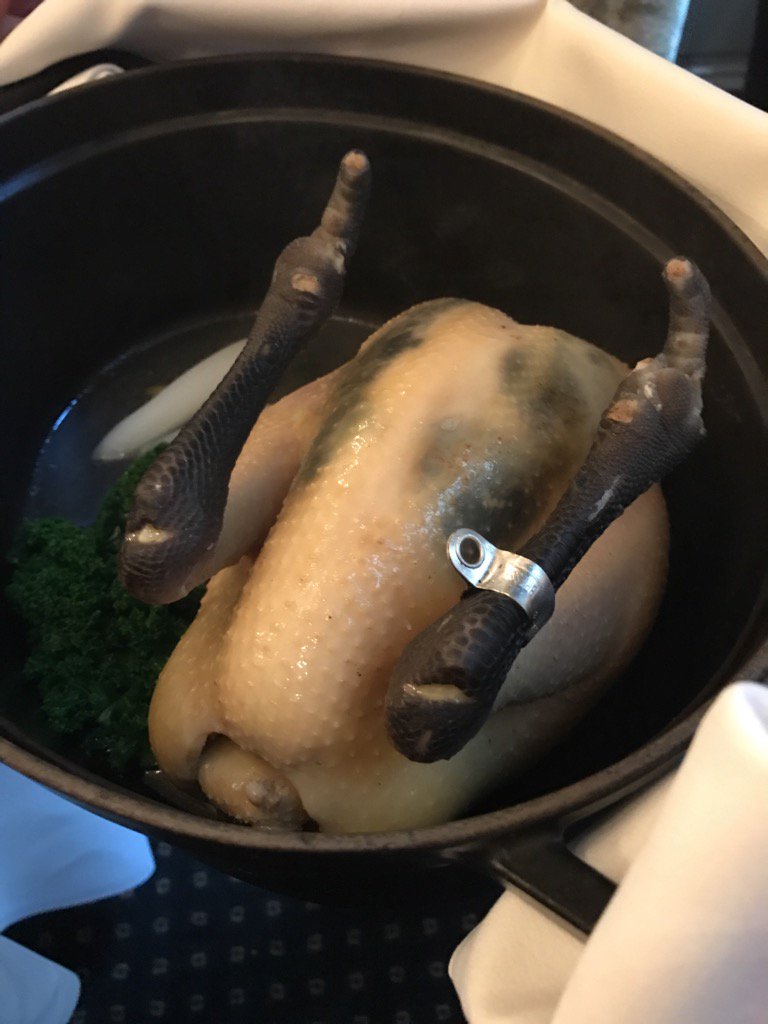
For three days in Lyon, we froze our asses off. It didn’t get above freezing for one minute, and no matter how much long underwear we put on (check out the layers I’m wearing in the picture below), the chill cut right through us. This can be explained partially by geography. Lyon – the second largest city in France — sits on an island between two rivers (much like Manhattan). On one side is the Saône, and on the other, the Rhone. Both act like long wet refrigerators chilling all air passing over them. This is probably a welcome thing in August, but I’ll never know. What I do know is that our lunch at La Mère Brazier warmed the cockles of my heart like no other.
The centerpiece of the lunch was poulet de Breese demi-deuil (poached Bresse chicken in half-mourning – pictured above and at the top of the article). Larousse Gastronomique calls it one of the most famous Lyonnaise dishes “particularly the version given by Mere Fillioux,” and mandates that the bird be of the highest quality and poached. The name comes from the dark truffles beneath the skin which give the appearance of a mourner’s veil hiding their white skin. Any recipe that roasts the bird, is little more than a chef’s short-cut and an abomination. An abomination I say!
As soon as we saw it on La Mère Brazier’s menu (for two, for 200 euros) we were hooked. For those of you who’ve never had Bresse chicken, the bird itself is a revelation — the white meat having none of the bland stringiness that plagues American chicken, and the dark meat having a finish that lasts until next Tuesday. The dish is served in two courses — one festooned with black truffles, the other a rich, chicken-truffle soup under a puff pastry dome — and is so good is could justify a transatlantic flight.
I thought long and hard about whether to book a table here or at Paul Bocuse. Both are old-fashioned restaurants (LMB dates to 1923, PB has held 3 Michelin stars since 1965), but too many chefs told me the food at Bocuse is tired and metronomic, so I opted for the older restaurant with one less star. I’m glad I did as there was nothing old-fashioned about La Mère Brazier except the building, the beautiful service and that beautiful bird.
 (Sommelier Alexandre Pons knows we have a sweet spot for Chartreuse)
(Sommelier Alexandre Pons knows we have a sweet spot for Chartreuse)BERNACHON

What can I say about Bernachon that hasn’t been said before. It may be the best chocolatier on earth. It certainly has the best goddamned hot chocolate in the goddamned universe:

So thick you can practically stand a spoon in it. And I would kill for one of their bon bons right now. Bean-to-bar chocolate has been all the rage in American chocolate circles for a few years now. They’ve been doing it here since 1953.
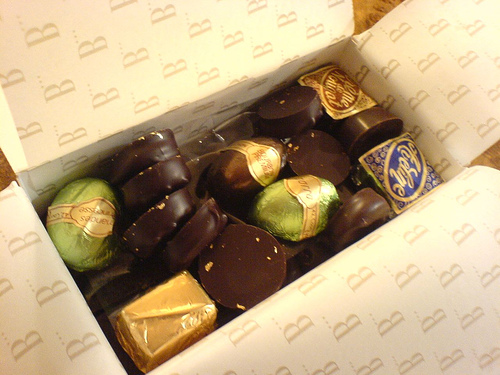
‘Nuff said.
LES HALLES PAUL BOCUSE
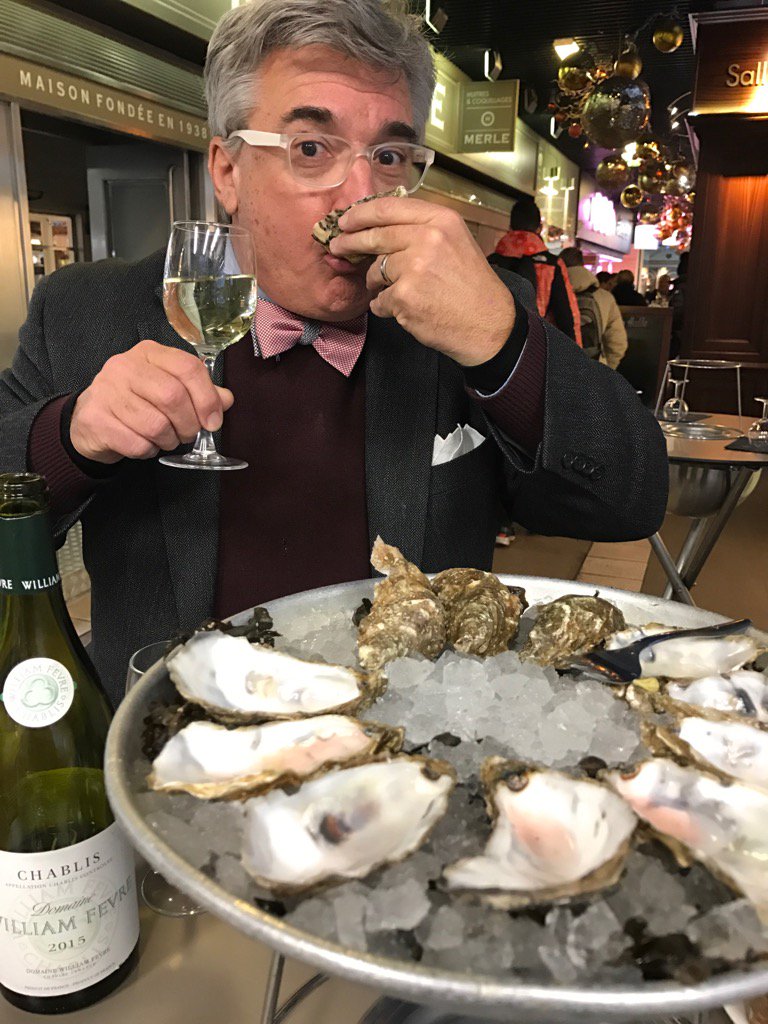 (Oysters and Chablis at 9:00 am. You gotta problem with that?)
(Oysters and Chablis at 9:00 am. You gotta problem with that?)
Les Halles Paul Bocuse are the food halls of Lyon. They’re not as huge or eye-popping as the markets in other large European cities (Venice and Barcelona spring to mind), but there’s no beating the French pastries there, or the Belon oysters:
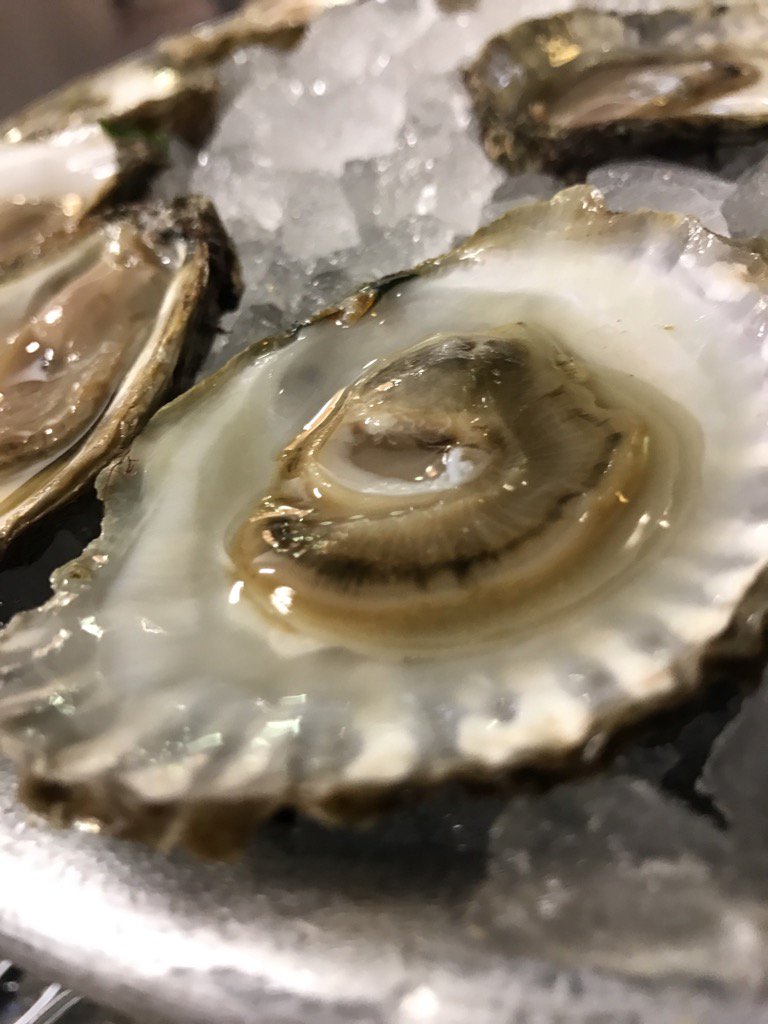
Also known as European flats, they are the world’s best bivalves — small, flat, sweet and saline, with a finish like licking a copper penny. There are worse ways to spend a morning in France than chugging down a bottle of Chablis with three dozen of these beauties. As you will see, we should’ve stayed at Les Halles, or ducked into one of the many bouchons (small bistros) that pepper the streets of Lyon, serving local specialties like pâté en croute and boudin noir. A bad bite in any of them is hard to find, or as our gourmet ami Sebastien Silvestri said, “They (the Lyonnaise) don’t know how not to make it good.”
Unfortunately, we found the one Michelin-starred restaurant in Lyon where that was not the case. Instead of seeking out a tasty bouchon, we wasted a meal at….
PIERRE ORSI

ELV hates wasting a meal. Any meal. Especially when he’s traveling in France. Ten years ago, we visited Pierre Orsi and were thoroughly charmed by the place. A decade on, the food tasted as dated as the décor. One dish dazzled us – a ravioli with foie gras and black truffles – the rest of our meal could’ve been from some pseudo-bistro in Bosnia . On the plus side, the service was wonderful and the wines were spectacular. (We never tire of drinking grand cru wines for 100 euros in France that would cost 4Xs that much over here.) But it’s going to be a long time before I forget my dried-out lobster, Monsieur et Madame Orsi.

In a perfect world, this would’ve have been our first big deal meal and not our last one. As it was, we made a spectacular drive to Les Trois Vallees (The Three Valleys) of the French Alps to La Bouitte (“Little House”) to experience the cuisine of René et Maxime Meilleur.
As it was, our meal here was taken after a solid week of eating in French and German restaurants. When that happens you hit the wall sometimes. And by “hit the wall” I mean what you experience what the French call la crise de foie (liver crisis) where your stomach (and liver) have ceased to function normally, and hunger becomes the last thing on your mind. Having been through these Michelin-starred rodeos before, my digestive system is well acquainted with la crise de foie, and the best one can hope for is no extreme gastrointestinal eruptions and a quick re-gaining of one’s appetite. Luckily, we had none of the former and powered through the latter, meaning: we ate our three-course dinner at La Bouitte (really more like eight courses when all the freebie courses are factored in), but we weren’t hungry for any of it in the least. In fact, so “not hungry” were we that, for the first time in twenty-five years, we skipped the cheese course.
To repeat, we skipped the cheese course. In a Michelin-starred restaurant. In France. No Tomme de Savoie, Beaufort, Reblochon or Gruyere or Comté would pass our lips this night. Au revoir, we said, to any Tamié, Tome des Bauges or Chevrotin. And kiss goodbye any thoughts of a Vacherin du Haut Doubs. “Quelle horreur!” we could hear the Julia Child screaming from her grave. But we simply could not stomach another bite.
Thus were we unable to fully enjoy one of the great, rustic dining rooms of the world, set amidst the splendor of the French Alps.:

…nor could we take the full measure of the Meilleur’s cuisine:

What we did have was the elevated cooking of the Savoyard, an area rich in pastures, lakes and rivers, and renowned for its fresh water fish. The Food Gal had the omble chevalier (arctic char), while I took the lake trout “bleu” and both were a revelation in the beauty of the local waters. The flavors were pure, simple and direct, as if the fish had jumped out of the stream and onto your plate. Every bite a testament to confident chefs who know they are working with supreme raw ingredients and only want to make them shine.
Which is exactly what they did with this plate of warm Savoie root vegetables:

….proof once again that great vegetarian cuisine does not come from vegetarian chefs.
Everything about La Bouitte — the room, the staff, the spa, the dinner, the two-fisted wine list:

….and the breakfast, was just about perfect. We can’t wait to return…the next time with a big appetite.
LE MONTAGNARD

Man does not live by Michelin-starred dining alone. Sometimes, all you want is a bunch of melted cheese on bread. And man, if that’s your thing, you’ll think you’ve died and gone to heaven in this part of the world. Cheese is king in the Savoie. Cow’s milk cheeses to be precise. And they know how to melt it right. With lots of gooey, winy goodness, served with a bracing glass of the local vin blanc. Chef John Courtney (who had also recommended La Bouitte) told us we needed to hit Le Montagnard for its authentic fondue, so that’s just what we did. From the wooden tables and plaster walls to the ski boots lining the front hallway, this is soul-warming, ski resort food at its best. You think you know from fondue? You don’t know from fondue until you’ve tasted one made with local Beaufort cheese.

Our last meal in France took place on the shores of Lake Annecy, known as “Europe’s cleanest lake.” It’s alpine, crystalline waters are known for all sorts of water sports, and also some of the tastiest omble chevalier in the business.
We stumbled upon Auberge du Roselet on the shores of the lake as we were driving to Lausanne, Switzerland. The sign said “Spécialties de Poissons” so we bit, and walked in, not knowing what to expect. What appeared was an unexpected treat, and the kind of out-of-the-way, knock-your-socks-off meal that only exists in France. The welcome was warm and cordial; the tables were dressed with thick linens, and the menu was the prettiest (and heaviest) I’ve ever seen. (see picture above). So pretty was it that we begged to take one; they said no. Then we offered to pay for one; they said “no, merci.” Finally, we contemplated stealing it. But the food was so good, and the view so stunning, and the staff so nice, we demurred.
With appetite restored, we feasted on delicately smoked ham:

Beautifully salmon fumé:

…and finally, the piece de resistance:

….a gorgeous omble chevalier specimen, swimming in butter, as it should be.
All of it from a modest little place along the road, on a country drive through the Haute-Savoie. Amazing, but seemingly par for the course in this part of the world.
Don’t let anyone ever tell you that France doesn’t have, top to bottom, the best restaurants in the world. If someone tries to tell you that, politely tell them they are wrong.
Food may be a passion in other parts of the world, but in France, it’s a religion.
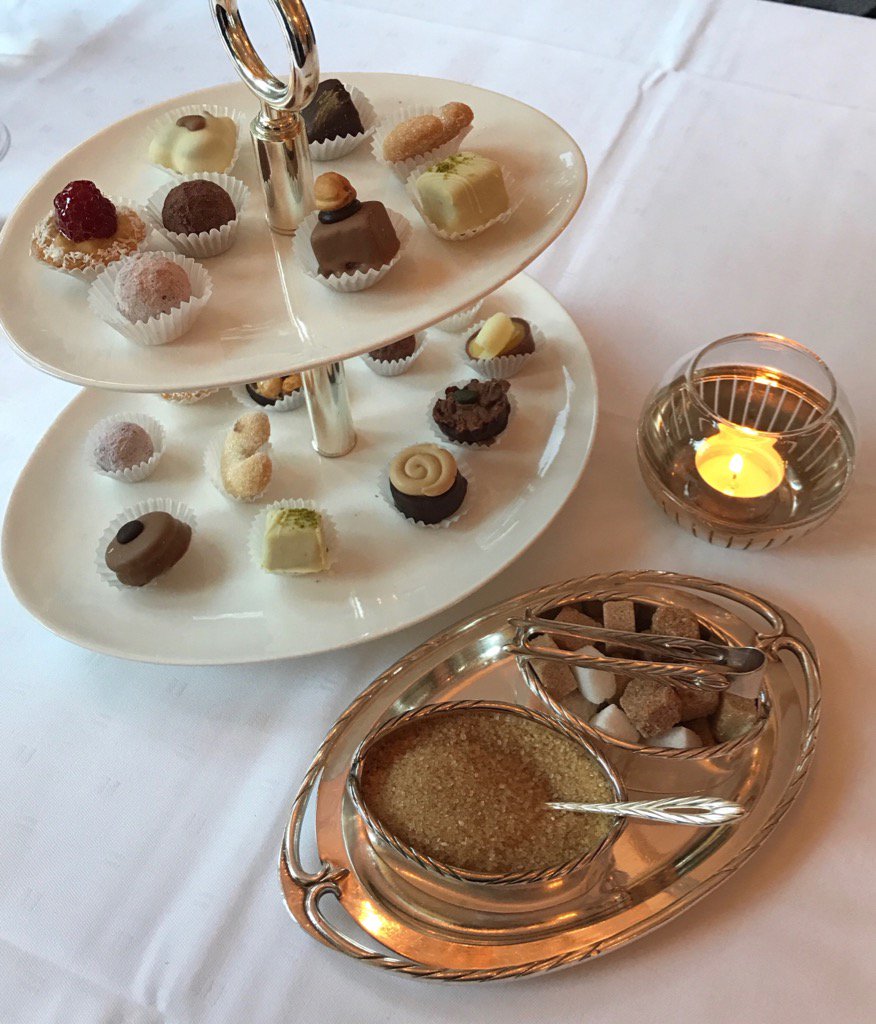 (Petit Fours is French for “I can’t believe they’re serving us more food!”)
(Petit Fours is French for “I can’t believe they’re serving us more food!”)WALDHOTEL SONNORA
Auf dem Eichelfeld 1, 54518
Dreis, Germany
64 Rue Monge, 21000
Dijon
Tel: 33 3 80 41 31 21
LE MONTRACHET
10 place du Pasquier de la Fontaine, 21190
Puligny-Montrachet
Tel: 33 3 80 21 30 06
LES HALLES PAUL BOCUSE
102 Cours Lafayette, 69003
Lyon
Tel: 33 4 78 62 39 33
BERNACHON
42, cours Franklin Roosevelt
Lyon
Tel: 04 78 52 67 77
LA MÈRE BRAZIER
12 Rue Royale, 69001
Lyon
Tel: 33 4 78 23 17 20
PIERRE ORSI
3 Place Kléber, 69006
Lyon
Tel: 33 4 78 89 57 68
LA BOUITTE
Saint Marcel, 73440
Saint-Martin-de-Belleville
Tel: 33 4 79 08 96 77
LE MONTAGNARD
Rue des Places, 73440
Saint Martin de Belleville
Tel: 33 4 79 01 08 40
AUBERGE DU ROSELET
182 Route d’Annecy, 74410
Duingt
Tel: 33 4 50 68 67 19

